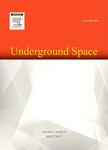Empirical approach for reliability evaluation of tunnel excavation stability using the Q rock mass classification system
作者机构:McMillen Jacobs AssociatesWalnut CreekCAUSA Department of Civil and Environmental EngineeringColorado School of MinesGoldenCOUSA Federal Energy Regulatory CommissionSan FranciscoCAUSA
出 版 物:《Underground Space》 (地下空间(英文))
年 卷 期:2022年第7卷第5期
页 面:862-881页
核心收录:
基 金:funding this research under Grant No.69A3551747118 from the US Department of Transportation(DOT) United States.
主 题:Reliability analysis Tunnel Critical strain Rock mass classification Q First order reliability method
摘 要:The critical strain concept has been widely used in analytical or numerical approaches to evaluate the stability of underground excavations.Analytical,empirical,and numerical procedures are usually used to determine the critical strain values.This paper presents a reliability assessment procedure for evaluating excavation stability using the empirical approach based on the rock mass classification Q and the first order reliability method(FORM).In contrast to deterministic critical strain values,a probabilistic critical strain,which considers uncertainties in rock mass parameters,was incorporated in a limit state function for reliability analysis.Using the rock mass classification Q,the empirically estimated tunnel stain was included in the limit state function.The critical strain and estimated tunnel strain were probabilistically characterized based on the rock mass classification Q-derived rock mass properties.Monte Carlo simulations were also conducted for comparing the reliability analysis results with those derived from the FORM algorithm.A highway tunnel case study was used to demonstrate the reliability assessment procedure.The effects of the input ground parameter correlations,probability distributions,and coefficients of variation on tunnel reliability were investigated.Results show that uncorrelated and normally distributed input parameters(intact rock strength and elastic modulus)have generated more conservative reliability.The reliability analysis results also show that the tunnel had relatively high reliability(reliability index of 2.78 and probability of failure of 0.27%),indicating the tunnel is not expected to experience instability after excavation.The tunnel excavation stability was assessed using analytical and numerical approaches for comparison.The results were consistent with the reliability analysis using the FORM algorithm’s Q-based empirical method.



